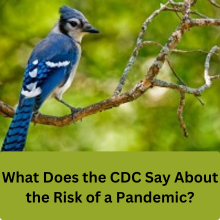
In 2024, the bird flu (H5N1) outbreak is raising alarms across the United States and beyond. With flu season already in full swing, public health experts are concerned about how the spread of avian influenza could intersect with the seasonal flu, creating a deadly combination. As cases continue to rise, questions abound about how serious this could become and whether we should be preparing for another lockdown.
What’s Happening with Bird Flu in 2024?
The bird flu situation is far from under control. In early 2024, the Centers for Disease Control and Prevention (CDC) reported 46 human infections from the H5N1 strain of bird flu. These infections span various regions, with a large portion linked to the poultry industry and dairy cattle, raising concern that these industries might be playing an unintended role in spreading the virus.
A new and particularly alarming development came from Canada, where a previously healthy teenager was reported to be in critical condition after contracting the virus. The case is especially concerning because the teenager had no direct exposure to farms, where the virus typically spreads. This raises the question: How does bird flu move from farms to humans—and could it soon adapt to spread easily among humans?
Understanding the H5N1 Strain of Bird Flu
H5N1, or highly pathogenic avian influenza, is one of the most concerning strains of bird flu. The virus is most commonly transmitted through direct contact with infected poultry, but it can also spread through contaminated environments. H5N1 is considered particularly dangerous due to its high fatality rate in birds and its potential to mutate in ways that might allow it to spread more easily among humans.
While the majority of cases so far have been linked to farm animals (especially poultry), there is growing concern that the virus could adapt and become more transmissible. This is why it’s crucial to understand how this strain works, and why authorities are monitoring the situation so closely.
Human Cases: How Serious is the Risk?
As of now, the number of human infections is relatively small. However, each new case is a cause for concern. Most reported cases in the U.S. have involved mild symptoms, such as conjunctivitis (red eyes) and flu-like respiratory issues. But the emergence of the first human case in Canada is a sign that this virus is beginning to spread beyond its usual animal hosts.
For the public, the immediate risk remains low. The CDC has stated that there have been no confirmed cases of human-to-human transmission yet. However, the more human cases that occur, the more opportunities the virus has to mutate into a form that could spread more easily among people.
What Does the CDC Say About the Risk of a Pandemic?
The CDC has been closely monitoring the situation, and their stance so far is reassuring. According to the CDC, while the risk to the general population remains low, the situation could change if the virus starts to mutate. If it were to gain the ability to transmit from human to human, the risk of a larger-scale outbreak or even a pandemic could increase.
Jeremy Rossman, a virology expert, has pointed out that because the population hasn’t been exposed to H5N1 before, there would be little immunity to this strain, making it a potential threat. The big unknown is how the virus might adapt and whether it would lead to mild illness or something more serious.
Why the U.S. Government is Monitoring the Situation Closely
The U.S. government is taking this outbreak seriously, primarily because of the long-term consequences a bird flu pandemic could have on public health. Unlike the flu strains that typically circulate each year, H5N1 could pose an entirely new risk due to the lack of immunity in the population. Authorities are closely watching animal-to-human transmission and potential mutations that could lead to more serious infections.
Bird Flu & Flu Season: A Dangerous Combination?
Flu season in the U.S. typically ramps up in the fall and peaks in the winter, coinciding with the highest levels of flu activity. This year, there’s an added concern: the bird flu. If the virus starts to spread among humans, the combination of seasonal flu and avian flu could lead to a surge in hospitalizations. The high rates of flu transmission during winter could make it harder to control a potential bird flu outbreak.
The reality is that the flu season could look very different this year. Hospitals could be overwhelmed by cases of both human flu and bird flu, leading to more serious consequences.
The Impact of a Potential Mutation: What Happens If It Becomes Transmissible Among Humans?
If the virus mutates to allow for human-to-human transmission, the implications could be significant. In past pandemics, flu strains that could be easily transmitted among humans have caused widespread illness and death. The concern with bird flu is that it could potentially cause an even higher mortality rate.
Historically, the bird flu has had a case fatality rate as high as 60% in some outbreaks. While no human-to-human transmission has occurred yet, scientists are concerned that the virus could mutate, and that a strain capable of spreading rapidly among humans could emerge.
Will Bird Flu Cause Future Lockdowns?
One of the major questions surrounding the bird flu outbreak is whether it could lead to lockdowns, similar to the COVID-19 pandemic. While there’s no clear answer yet, experts have stated that any such measures would depend on the virus’s ability to spread among humans. If the virus mutates into a highly contagious form, it could potentially lead to public health interventions, such as quarantines or even nationwide lockdowns.
The global response would likely mirror that of past pandemics, with governments working to contain the spread of the virus through travel restrictions and social distancing measures.
Could We See a Global Pandemic?
The possibility of a global pandemic remains uncertain. While bird flu in humans has been rare, every new case presents an opportunity for the virus to adapt. If human-to-human transmission occurs, we could see a much larger-scale outbreak, potentially on a global scale. However, much depends on how the virus evolves in the coming months.
The Role of Pigs and Other Animals in Disease Transmission
Another concern arises from the discovery of bird flu on a pig farm in Oregon. Pigs are known to be “mixing vessels” for viruses, meaning they can host both bird and human viruses, allowing for mutations that could lead to new strains. The potential for this mutation to spread to humans is a serious concern, especially as more farms across the country report cases of the virus.
How Does the Virus Spread Among Animals?
Bird flu typically spreads through direct contact with infected poultry or contaminated environments. However, the virus can also spread through the air, making it easier for animals like pigs and other livestock to become infected. Once infected, animals can pass the virus on to humans, particularly farm workers.
Also read: Wholesale Prices Jump 0.2% in October: Which Cities Felt It?
What Are the Symptoms of Bird Flu in Humans?
Symptoms of bird flu in humans are typically mild but can include fever, chills, cough, and muscle aches. However, more severe cases may involve respiratory distress and even organ failure. It’s important to keep an eye out for flu-like symptoms, especially if you’ve had recent exposure to poultry or other livestock.
Preparing for the Worst: What Can Be Done?
As the flu season progresses, it’s crucial to take preventive measures. Wash your hands frequently, avoid close contact with sick individuals, and consider wearing masks in crowded areas. It’s also important to stay up-to-date on vaccines and flu shots, which can help reduce the impact of seasonal flu.
Is There a Vaccine for Bird Flu?
At present, there is no widely available vaccine specifically for bird flu. However, scientists are working on vaccine development, and some countries have stocks of bird flu vaccines in case of a larger outbreak.
How Can You Protect Yourself and Your Family?
To protect yourself, avoid exposure to infected animals and practice good hygiene. If you work in agriculture or have direct contact with poultry or livestock, be especially cautious. If you experience flu-like symptoms, seek medical attention immediately.
Also read: Bad Sisters Season 2: Anne-Marie Duff Teases Shocking Plot Twists
Conclusion
The rise in bird flu cases in 2024 presents a unique challenge during the flu season. While the risk to the general public remains low, the potential for mutation and human-to-human transmission makes it a serious concern. As we approach the colder months, it’s essential to remain vigilant and prepared for any developments.
FAQs
-
What exactly is bird flu and how does it spread?
- Bird flu is a contagious virus that primarily affects poultry but can spread to humans through direct contact with infected animals or contaminated environments.
-
How serious is the risk of bird flu becoming a pandemic?
- The risk of a pandemic depends on whether the virus mutates to become transmissible between humans. While the threat remains low, scientists are closely monitoring the situation.
-
Can bird flu spread from animals to humans?
- Yes, bird flu can spread from infected animals, particularly poultry, to humans. However, human-to-human transmission has not been reported yet.
-
How can I protect myself from bird flu?
- Practice good hygiene, avoid contact with sick animals, and stay informed about any public health warnings in your area.
-
What would trigger a lockdown due to bird flu?
- A widespread outbreak of human-to-human transmission could potentially trigger lockdowns, similar to measures seen during the COVID-19 pandemic. However, much depends on the virus’s evolution and severity.

